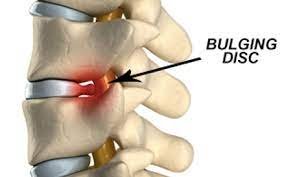
Living with a disc bulge can be a challenging journey, marked by pain, discomfort, and limitations in daily activities. Fortunately, in the bustling suburb of Mulund West, individuals grappling with this condition have access to a range of treatment options aimed at alleviating symptoms and restoring quality of life. From conservative approaches to advanced interventions, let’s explore the diverse disc bulge treatment in Mulund West.
Understanding Disc Bulge:
Before delving into treatment options, it’s essential to understand what a disc bulge entails. Intervertebral discs, located between the vertebrae of the spine, act as shock absorbers, providing cushioning and flexibility. A disc bulge occurs when the outer layer of a disc weakens or tears, causing the inner gel-like material to protrude outward. This can lead to compression of nearby nerves, resulting in pain, numbness, tingling, and weakness in the affected area.
Conservative Treatment Approaches:
In many cases, disc bulge symptoms can be effectively managed through conservative treatment measures. Physiotherapy plays a central role in this approach, focusing on strengthening the supportive muscles of the spine, improving posture, and promoting flexibility. Physiotherapists in Mulund West employ a variety of techniques, including manual therapy, therapeutic exercises, traction, and modalities such as ultrasound and electrical stimulation, to alleviate pain and enhance spinal stability.
Additionally, lifestyle modifications, such as maintaining a healthy weight, practicing proper body mechanics, and incorporating ergonomic adjustments in daily activities, can help mitigate symptoms and prevent further aggravation of the disc bulge.
Advanced Interventional Treatments:
In cases where conservative measures yield inadequate relief or when symptoms are severe, advanced interventional treatments may be considered. One such option is epidural steroid injections, wherein anti-inflammatory medication is injected directly into the epidural space around the affected nerve roots. This can help reduce inflammation and alleviate pain, providing temporary relief for individuals struggling with persistent symptoms.
Another advanced treatment modality gaining popularity is spinal decompression therapy. This non-invasive technique involves gently stretching the spine to relieve pressure on the affected discs and nerves, promoting the retraction of the bulging disc material and facilitating healing. Spinal decompression therapy is often combined with other modalities, such as laser therapy or electrical stimulation, to enhance its efficacy in managing disc bulge symptoms.
Surgical Options:
While surgery is typically considered a last resort for disc bulge treatment, it may be necessary in cases of severe or progressive neurological deficits, or when conservative and interventional measures fail to provide adequate relief. Surgical procedures for disc bulge treatment in Mulund West may include discectomy, laminectomy, or spinal fusion, depending on the specific characteristics of the disc bulge and the individual’s unique circumstances. It’s important to consult with a qualified spine surgeon to discuss the risks, benefits, and expected outcomes of surgical intervention thoroughly.
Holistic Approach to Healing:
Regardless of the chosen treatment modality, adopting a holistic approach to healing is paramount in managing disc bulge effectively. This encompasses not only addressing the physical aspects of the condition but also attending to the emotional and psychological well-being of the individual. Mind-body practices such as yoga, meditation, and mindfulness can complement traditional treatment methods, promoting relaxation, stress reduction, and overall wellness.
In conclusion, individuals dealing with disc bulge in Mulund West have a variety of treatment options at their disposal, ranging from conservative measures to advanced interventions. By collaborating with experienced healthcare professionals, adopting a comprehensive treatment plan tailored to individual needs, and embracing a holistic approach to healing, individuals can find relief from disc bulge symptoms and embark on a journey toward improved spinal health and well-being.
Expanding on Conservative Treatment Approaches:
Physiotherapy is a cornerstone of conservative disc bulge treatment, offering a multifaceted approach to address symptoms and promote healing. Manual therapy techniques, such as spinal mobilizations and manipulations, aim to restore proper alignment and movement of the spine, reducing pressure on the affected discs and nerves. Therapeutic exercises play a crucial role in strengthening the muscles that support the spine, improving flexibility, and enhancing overall spinal function. These exercises may include core stabilization exercises, stretching, and functional movements tailored to the individual’s specific needs and limitations.
In addition to manual therapy and exercise, physiotherapists may utilize modalities such as ultrasound, electrical stimulation, and heat or ice therapy to further alleviate pain and inflammation associated with disc bulge. Ultrasound therapy delivers high-frequency sound waves to deep tissues, promoting circulation and accelerating the healing process. Electrical stimulation, including transcutaneous electrical nerve stimulation (TENS) and interferential current (IFC) therapy, can help modulate pain signals, providing temporary relief from discomfort. Heat and ice therapy are commonly used to reduce inflammation, relax muscle spasms, and alleviate acute pain symptoms.
Beyond the clinic, physiotherapists often provide education and guidance on ergonomic principles and lifestyle modifications to optimize spinal health and prevent recurrence of disc bulge symptoms. This may involve ergonomic assessments of workstations and daily activities to identify and address potential sources of strain or injury. Additionally, advice on proper lifting techniques, posture correction, and ergonomically designed furniture and equipment can empower individuals to take proactive steps in managing their condition and promoting long-term spinal wellness.
Exploring Advanced Interventional Treatments in Depth:
Epidural steroid injections (ESIs) are a commonly utilized interventional treatment option for individuals experiencing persistent or severe pain due to disc bulge. During this procedure, a combination of corticosteroid medication and local anesthetic is injected directly into the epidural space surrounding the affected nerve roots. The corticosteroid acts as a potent anti-inflammatory agent, reducing swelling and inflammation around the compressed nerve, while the anesthetic provides immediate pain relief. ESIs can provide significant relief from disc bulge symptoms, allowing individuals to participate more comfortably in physiotherapy and other rehabilitative activities aimed at addressing the underlying causes of their condition.
Spinal decompression therapy is another advanced treatment modality that has shown promise in managing disc bulge symptoms and promoting spinal health. This non-invasive technique involves the use of specialized equipment to gently stretch the spine, creating negative pressure within the affected discs and promoting the retraction of bulging disc material. By decompressing the spine, spinal decompression therapy can alleviate pressure on the affected nerves, reduce pain and inflammation, and improve overall spinal function. This therapy is typically performed in a clinical setting under the supervision of a trained healthcare provider and may be combined with other modalities, such as laser therapy or electrical stimulation, to enhance its effectiveness.
In some cases, minimally invasive surgical procedures may be considered for individuals who have not responded to conservative or interventional treatments and continue to experience significant pain and functional impairment due to disc bulge. Minimally invasive techniques, such as percutaneous discectomy or endoscopic discectomy, involve the removal of a portion of the bulging disc material through small incisions, minimizing disruption to surrounding tissues and reducing the risk of complications associated with traditional open surgery. These procedures are typically performed on an outpatient basis and may offer faster recovery times and less postoperative pain compared to conventional surgical approaches.
Incorporating a Holistic Approach to Healing:
While physical interventions play a central role in the management of disc bulge, it’s essential to recognize the interconnectedness of physical, emotional, and psychological factors in overall well-being. Adopting a holistic approach to healing can help individuals address these aspects of their health and optimize their recovery from disc bulge.
Mind-body practices, such as yoga, meditation, and mindfulness, can be valuable adjuncts to traditional treatment methods, promoting relaxation, stress reduction, and emotional resilience. These practices have been shown to help individuals cope with chronic pain, improve mood and mental well-being, and enhance overall quality of life. By incorporating mind-body techniques into their daily routine, individuals with disc bulge can cultivate greater self-awareness, develop healthier coping mechanisms, and foster a greater sense of empowerment and control over their health and healing journey.
Nutrition also plays a crucial role in supporting spinal health and overall well-being. A balanced diet rich in nutrients such as vitamins, minerals, antioxidants, and omega-3 fatty acids can help reduce inflammation, support tissue repair and regeneration, and promote optimal musculoskeletal function. Additionally, maintaining a healthy weight can help reduce strain on the spine and minimize the risk of developing or exacerbating disc bulge symptoms. Healthcare professionals, including physiotherapists and nutritionists, can provide personalized dietary recommendations and guidance to help individuals make informed choices about their nutrition and optimize their recovery from disc bulge.
Furthermore, fostering a supportive social network and seeking out emotional support can be instrumental in navigating the challenges of living with disc bulge. Connecting with family, friends, and support groups who understand and empathize with their experiences can provide individuals with a valuable source of encouragement, validation, and practical assistance. Additionally, seeking professional counseling or therapy can help individuals develop coping strategies, address underlying emotional issues, and cultivate greater resilience in the face of adversity.
In conclusion, the management of disc bulge requires a multifaceted approach that addresses the physical, emotional, and psychological aspects of the condition. By combining physical interventions such as physiotherapy, interventional treatments, and, in some cases, minimally invasive surgery with holistic healing practices such as mind-body techniques, nutrition, and social support, individuals can optimize their recovery and improve their quality of life. With the guidance and support of knowledgeable healthcare professionals and the commitment to proactive self-care, individuals with disc bulge can find relief from their symptoms and regain control over their health and well-being.
Visit more articles on:- https://toastul.com/
